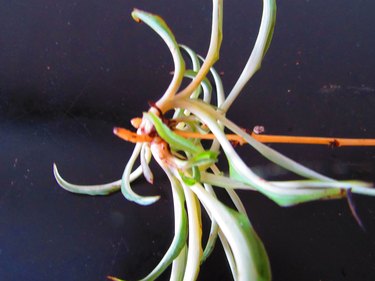
If black widow spiders multiplied in the same way that spider plants do, it would be the stuff of nightmares. Imagine a spider with dozens of babies hanging from its body, each one waiting to fall and fulfill its destiny! But when it comes to spider plants (Chlorophytum comosum), nothing could be cuter.
Whether or not you want your spider plant to propagate, it is likely to do so. Mature plants develop pale, drooping runners. Miniature versions of the parent plant grow on the stalks. I call them spidies, but some gardeners call them spiderettes or spider babies. Each one will develop a little root system, at which time they can be clipped off and planted in their own little containers.
Video of the Day
Video of the Day
Spider Plant Propagation Options
While it is possible to propagate a spider plant by dividing up the root ball of an existing plant, I don't know anyone who does this with houseplants. It can be handy for outdoor spider plants in very warm hardiness zones where the plants can spread outside their assigned garden bed.
But for houseplant propagation, clipping off and planting baby spidies is the way to go. I get so many baby plants that I run an ongoing "free spider plant babies" post on my neighborhood website. You can pop them into soil or a glass of water.
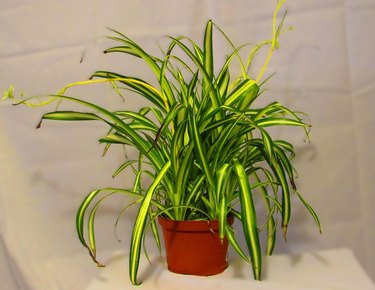
When to Propagate a Spider Plant
A good general rule for houseplants is to propagate them during the active growing season: spring or summer. Be sure to provide sufficient water during this period since drought can prevent spider plants from producing babies.
Are you shaping or pruning back your plant in spring or summer? This is a perfect time to snip off those runners—the plant looks much neater without them—and root out the babies.
What about division? It's a houseplant, so don't fret about the timing. If you think the plant is crunched in its container, it's a good time to divide.
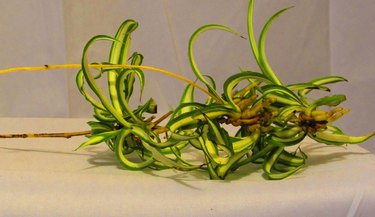
Things You'll Need
Healthy spider plant with spidies
Garden knife, scissors, or pruners
Small pot or container
Succulent potting soil
Propagating Spider Plants by Division
If you decide to propagate your spider plant houseplant by division, it's a simple process. While holding the container, tip the plant until the root ball slips out. Leave it on its side and then use a sterilized knife to divide it vertically into two or three pieces.
Prepare containers for each division. Each should be twice the size of the division to be transplanted, and they should have drain holes. Replant each division using succulent potting soil. Water well.
Propagating Spider Plants From Babies
Once a spider plant is a year old, it will produce long, pale runners on which miniature spider babies grow. The stalks dangle on all sides of the parent plant. The babies grow larger, and in a week or so, you'll see little white nubs growing on the bottom of each spiderette.
These are young roots that will grow into a pretty healthy root system. You may have to divide two that grow close to one another. You have three options for propagating from these babies:
- Clip a baby off its runner and plant it in soil.
- Leave a baby attached to the runner but plant its roots in soil.
- Clip a baby off its runner and let the roots develop in water.
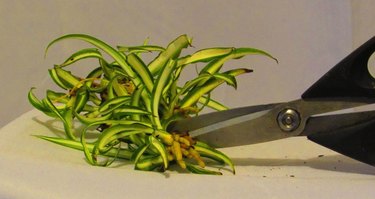
Clip and Propagate in Soil
Wait until the root system looks large enough to support the young plant. Prepare a small container with good drain holes by filling it up with succulent potting soil. Snip the spiderette off the runner. Plant the roots in the potting soil. Water well and then water again when the soil is dry to the touch.
This is my number one choice for propagating spidies. I have never had one fail, although some claim that leaving the spiderette attached is more consistently successful.
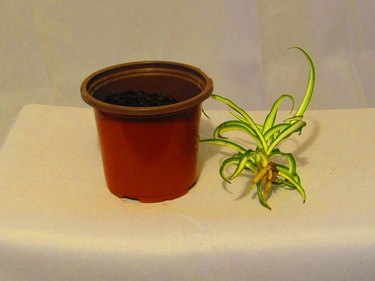
Leave Spidie Attached and Propagate in Soil
The spider baby doesn't need to be cut from the runner for it to establish its roots in soil. In fact, my outdoor spider plants regularly produce spiders on runners. The runners continue growing until the spidies touch dirt; then, they root there. So, duplicate this if you like by leaving the spidies attached but providing little pots of soil for them to grow in. After a few weeks of establishment, the spider baby is clipped from the runner and becomes its own plant.
Clip and Propagate in Water
Clip off a baby with a strong root system. Get a small see-through glass, fill it halfway with distilled water, and pop the baby's roots into it. This has no advantage over soil rooting other than the opportunity to watch those roots develop. Once they grow to a length of a couple inches, transplant them into little pots of soil. Again, the pots should have drain holes, and the soil should offer excellent drainage.
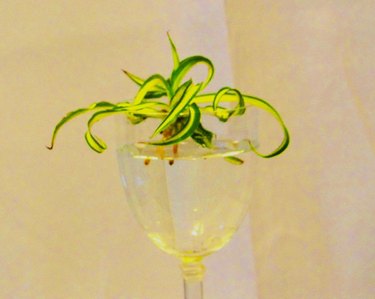
Frequently Asked Questions
Are there any disadvantages to rooting babies in water?
There are no disadvantages in terms of plant development, but it adds one step that is not essential. You'll need to place the baby in water and then transplant it to soil in a week or two, whereas planting it in soil is one-and-done. But it is a treat to watch how quickly the roots of this plant develop.
What can you do with all those babies?
First, create lush and lovely new plants by combining three or even four rooted babies in a larger pot. While one alone is cute, larger plants are astonishingly lovely. Second, pot up the babies and give them away. Most people would like a spider baby, and like kittens, they are hard to resist. On the other hand, unlike kittens, they don't require much hands-on attention.